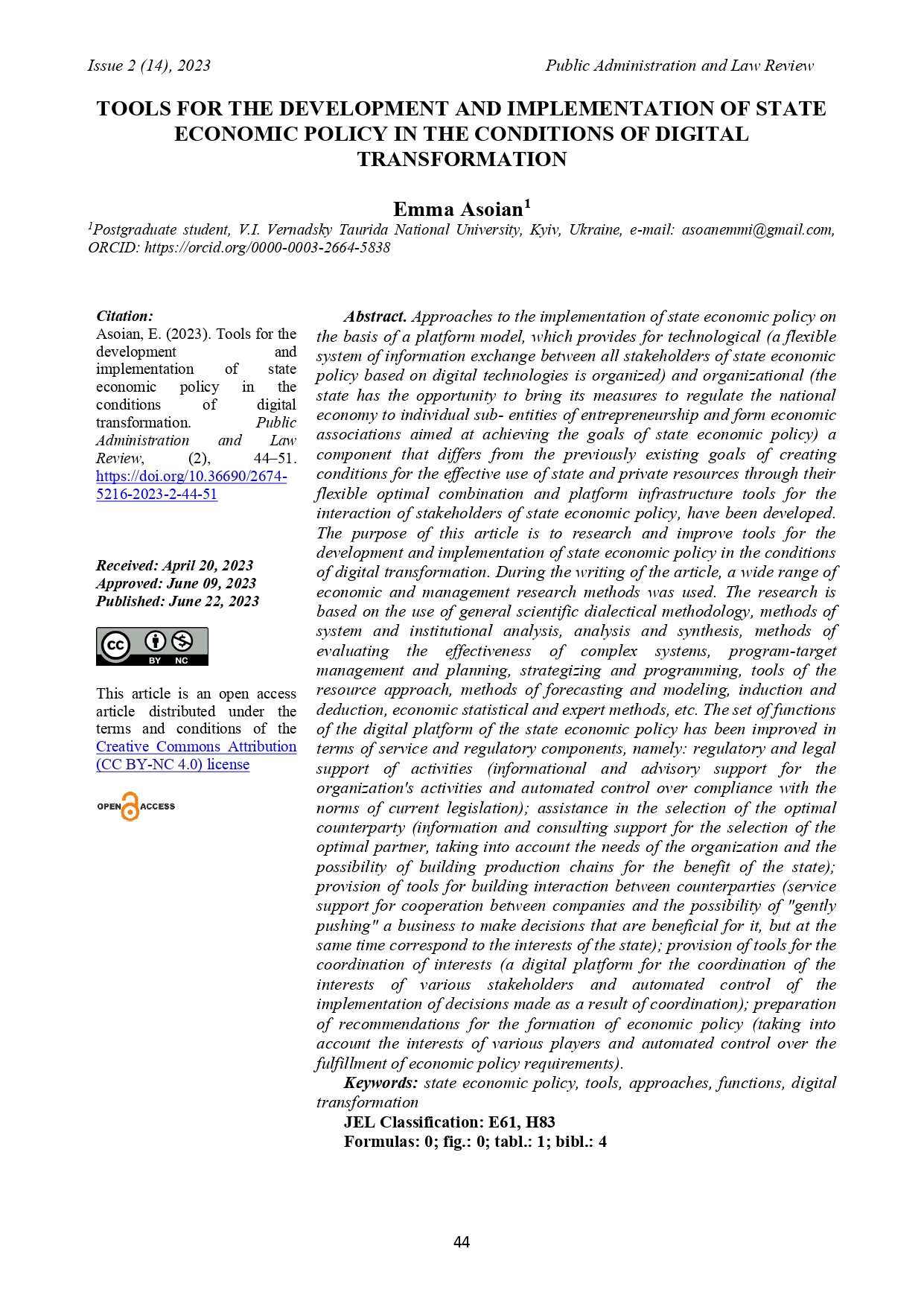TOOLS FOR THE DEVELOPMENT AND IMPLEMENTATION OF STATE ECONOMIC POLICY IN THE CONDITIONS OF DIGITAL TRANSFORMATION
DOI:
https://doi.org/10.36690/2674-5216-2023-2-44-51Keywords:
state economic policy, tools, approaches, functions, digital transformationAbstract
Approaches to the implementation of state economic policy on the basis of a platform model, which provides for technological (a flexible system of information exchange between all stakeholders of state economic policy based on digital technologies is organized) and organizational (the state has the opportunity to bring its measures to regulate the national economy to individual sub- entities of entrepreneurship and form economic associations aimed at achieving the goals of state economic policy) a component that differs from the previously existing goals of creating conditions for the effective use of state and private resources through their flexible optimal combination and platform infrastructure tools for the interaction of stakeholders of state economic policy, have been developed. The purpose of this article is to research and improve tools for the development and implementation of state economic policy in the conditions of digital transformation. During the writing of the article, a wide range of economic and management research methods was used. The research is based on the use of general scientific dialectical methodology, methods of system and institutional analysis, analysis and synthesis, methods of evaluating the effectiveness of complex systems, program-target management and planning, strategizing and programming, tools of the resource approach, methods of forecasting and modeling, induction and deduction, economic statistical and expert methods, etc. The set of functions of the digital platform of the state economic policy has been improved in terms of service and regulatory components, namely: regulatory and legal support of activities (informational and advisory support for the organization's activities and automated control over compliance with the norms of current legislation); assistance in the selection of the optimal counterparty (information and consulting support for the selection of the optimal partner, taking into account the needs of the organization and the possibility of building production chains for the benefit of the state); provision of tools for building interaction between counterparties (service support for cooperation between companies and the possibility of "gently pushing" a business to make decisions that are beneficial for it, but at the same time correspond to the interests of the state); provision of tools for the coordination of interests (a digital platform for the coordination of the interests of various stakeholders and automated control of the implementation of decisions made as a result of coordination); preparation of recommendations for the formation of economic policy (taking into account the interests of various players and automated control over the fulfillment of economic policy requirements).
Downloads
References
Coleman, S., Freelon, D. Introduction: Concep- tualizing Digital Politics. In Handbook of Digital Politics / S. Coleman, D. Freelon – editors. Cheltenham : Edward Elgar, 2015. P. 1–16.
Kreiss, D. Digital Opportunity Structures: Explaining Variation in Digital Mobilization during the 2016 Democratic Primaries. In Carpini, Digital Media and Democratic Futures / M. Delli – editor. Philadelphia: University of Pennsylvania. 2019. P. 42–68.
Koc-Michalska, K., Lilleker, D. Digital Politics: Mobilization, Engagement, and Participation. Political Communication. 2017. Vol. 34. No 1. P. 1–5.
Hoff, J., Scheele, C. Theoretical Approaches to Digital Services and Digital Democracy: The Merits of the Contextual New Medium Theory Model. Policy & Internet. 2014. Vol. 6. No 3. P. 241–267.

Downloads
Published
How to Cite
Issue
Section
License

This work is licensed under a Creative Commons Attribution-NoDerivatives 4.0 International License.





